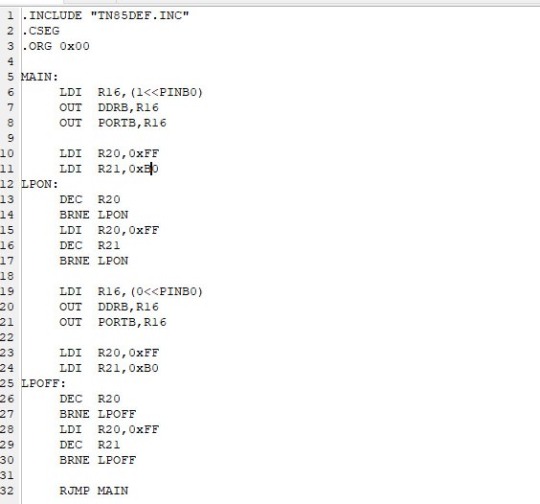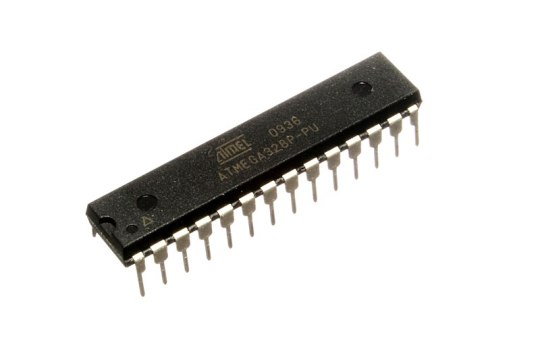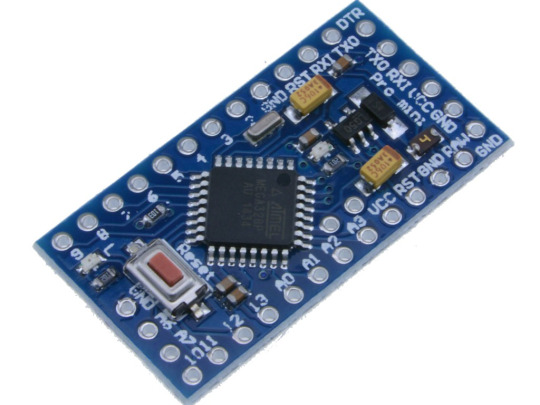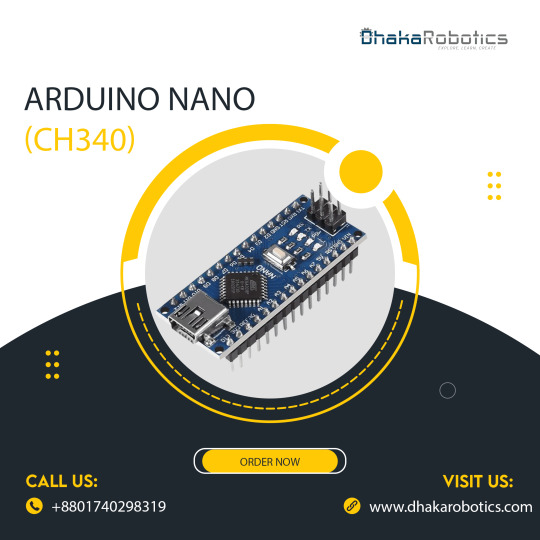#atmega328
Explore tagged Tumblr posts
Text
aitendo
ATYANDiiNO
あちゃんでいいの
0 notes
Text
Arduino Pro Mini 328 5V/16Mhz - Compact Powerhouse for Your Projects!
Unleash your creativity with the Arduino Pro Mini 328, a small yet powerful microcontroller board designed for DIY enthusiasts and professionals alike! With its 5V operating voltage and 16MHz clock speed, this board offers the performance you need for a wide range of applications, from robotics to home automation.
Key Features:
Microcontroller: ATmega328P - the same chip as the popular Arduino Uno.
Operating Voltage: 5V - ideal for compatibility with most sensors and modules.
Clock Speed: 16MHz - ensures fast and reliable operation.
Compact Size: Perfect for space-constrained projects where every millimeter counts.
Low Power Consumption: Efficient design for battery-operated projects.
Whether you're building a smart gadget, a sensor network, or an interactive art piece, the Arduino Pro Mini 328 is your go-to board for reliable performance in a tiny footprint. Ready to take your projects to the next level? Get yours today and start innovating!
Click here to purchase the product: https://dhakarobotics.com/.../1007-arduino-pro-mini-328.../
Contact Us: +8801740298319
visit our website: https://dhakarobotics.com/
##########

0 notes
Text
ATMEGA328P-PU: The Little Prince of Microcontrollers in Circuits & Stars
A Meeting in the Desert of Circuits
The desert stretched endlessly, its sands glowing like gold under the sun. I was tracing the dunes, heading toward a distant oasis, when I spotted a glint in the sand—a small, rectangular shape, no bigger than a ladybug.
“You’re… very small,” I said, kneeling. “And you’re a child who talks to microcontrollers,” it replied, voice soft as the wind. “But some keepers of light are smallest when they’re strongest. Ask the fox.”
It was an ATMEGA328P-PU—the heart of Arduino Uno, but to me, it felt like a secret. Let me tell you its story.

1. What Is the ATMEGA328P-PU? (A Keeper of Code, Not Just Silicon)
This was no ordinary chip. It was a ATMEGA328P-PU, an 8-bit AVR microcontroller in a 28-pin DIP suit—smaller than a baobab seed, but tough as the roots of the rose’s planet. Here’s its secret:
Clock Speed: 16-20MHz (overclockable to 24MHz for daredevils). Faster than the fox darting across the dunes.
Memory: 32KB Flash (stores code), 2KB SRAM (variables), 1KB EEPROM (your debugging tears). Like a Pensieve for electrons.
I/O Pins: 23 programmable pins (14 digital, 6 analog). Windows to the world—like the portholes on a spaceship.
Fun Fact: Engineers call it the “Cockroach of MCUs.” Survives power surges, cosmic rays, and your “hold my beer” coding experiments. Even the baobabs can’t crush it.
“Why so quiet?” I asked. “Keepers don’t shout,” it said. “They just keep.”
2. ATMEGA328P-PU & Its Siblings: Stars in the Same Sky
In the desert of microcontrollers, ATMEGA328P-PU has siblings—some older, some louder, but none quite like it:
ATMEGA328-PU: An older star. Higher power draw, like a planet that burns too bright. Avoid—like flip phones in 2025.
ATMEGA328PB-PU: A louder sibling. Extra peripherals (UART, timers), but bulkier. For complex projects, like a planet with too many volcanoes.
ATMEGA328P-PU: The steady one. Lower power (1.8V-5.5V), optimized code. Ideal for battery-powered projects—like a rose that blooms in the desert.
Roast Alert: ATMEGA328-PU (grumbling): “I’m vintage!” ATMEGA328P-PU (calm, like the fox): “I’m in NASA prototypes. You’re in a landfill. Bye.”

3. Why the Fox (and Engineers) Choose It
ATMEGA328P-PU isn’t flashy. It’s the kind of friend who shows up, fixes your code, and leaves without fanfare. Here’s why:
Cost: $3/unit—cheaper than a morning espresso (and way more useful). Even the rose, who’s picky, approves.
Simplicity: No Wi-Fi tantrums or driver hell (looking at you, ESP32). Like a well-tended garden—no weeds.
Community Support: 10k+ Arduino tutorials. Google is your co-pilot, and the fox is your guide.
Real-World Flex:
Mars Rover Prototypes: Runs in -40°C labs (tested by NASA JPL). Even cosmic frost can’t stop it.
DIY COVID Ventilators: 2020’s MacGyver hero (MIT Open-Source Project). Saved lives, one byte at a time.
“Why not be bigger?” I asked. “Big things break,” it said. “Tiny things fit. In garage labs. In Mars rovers. In portable ECGs.”
4. Programming the Little Prince: A Dance with Code
Want to wake the ATMEGA328P-PU? It’s like taming a fox—gentle, patient, and rewarding.
Option 1: Arduino IDE (The Friendly Path)
Connect via USB-to-Serial (e.g., CH340G). Pray the drivers install (sometimes they don’t—blame AliExpress).
Select Board: Arduino Uno (even if you’re using a breadboard).
Upload Code: Watch the LED blink, like a star winking hello.
Option 2: Bare-Metal with AVRDUDE (The Adventurer’s Path)
Command: avrdude -c usbasp -p m328p -U flash:w:your_code.hex
Pro Tip: If smoke appears, take a breath. The fox says, “It’s not your fault—sometimes stars misbehave.”

5. Burning the Bootloader: Tending the Rose
Burning a bootloader is like planting a rose—delicate, but necessary.
Tools Needed:
Programmer: USBasp, Arduino as ISP, or a sacrificial Uno (no tears, it’ll forgive you).
Software: Arduino IDE or AVRDUDE (the gardener’s tools).
Steps:
Wire It Up: Connect MOSI, MISO, SCK, RESET, GND, VCC. Triple-check—no one likes a fried rose.
Arduino IDE: Tools > Programmer > USBasp (or your tool).
Burn: Tools > Burn Bootloader. Wait for the magic (or error messages—they’re just the rose’s thorns).
1 note
·
View note
Text
First ATTINY85 project!
(warning: video has actual flashing LED lights)
[ Video ID: A breadboard with a Blue LED on top of an 8-pin DIP Integrated Circuit on it. The Blue LED is flashing rapidly. There are other components on the breadboard in the background. End ID ]

Last week I bought some ATTINY85 Microprocessors to experiment and work with :) With my W65C02 project on hold until I can afford an oscilliscope, and my Radio project delayed because I can’t quite figure out how to reverse engineer the 8 pins on the volume knob, I wanted something else to work with. I’ve been wanting to mess with Atmel microprocessors (Arduino Uno runs on an Atmel ATMEGA328), and now’s a good chance!
I’m jumping straight to assembly with the ATTINY85; I don’t know any C/C++ code, and also I’m familiar with other processor Assembly languages, so I might as well. And other than different names for functions, it’s been pretty easy so far! Something I’m not used to is that this processor, despite being pathetically tiny, has 32 registers; I’m used to working with 8 Max.
Anyways, for the code explanation: When the processor first starts, it turns on PINB0, which is physical pin 5 on the processor. Then, after counting to 256 256 times, it turns off PINB0 for another 256^256 counts. I’m away from home while writing this, so my notes arn’t here, but if I remember correctly it came up to 200k microseconds? That adds up to about 400 nano seconds per on/off cycle, or 2.5 flashes per second. I can add in another loop to make it last longer, but before I do that I’d like to look about to see if there’s a smarter way to tackle this.
My next step after this, is to figure out how to get this processor to read digital inputs: My next project is to finally do something with my box of telephone rotary dials. I already have one spec’ed out for breadboard testing. I would LOVE to show it, but Tumblr has a One Video Per Post limit :(
13 notes
·
View notes
Text
Arduino Nano Board R3 with CH340 chip

Based on the Arduino platform, the Nano R3 Board CH340 Chip without USB Cable does all the functions of the Uno, but has a smaller footprint.
Using Nano CH340 Soldered Board R3 Chip without USB cable is essential for your small project where you don’t need many pins, but the small size is very important to make it look nice.
In comparison to older versions of Arduino Nano with FTDI USB-Serial Chip, the Nano uses a low-cost USB-Serial Chip.
With the ATmega328 (Arduino Nano R3), the Nano is small, complete, and breadboard-friendly. It has more or less the same functionality as the Arduino Uno but in a different package. In addition to lacking a DC power jack, it uses a Mini-B USB cable instead of a standard one.
This device can be powered by a mini-USB cable, a 6-20V unregulated external power supply (pin 30), or a 5V regulated external power supply (pin 27).
Six PWM I/O are included from a total of 14 digital I/O, eight analog inputs, 16Mhz clock speed, and 32kB flash memory.
Please note:
The CH340 chip might not work directly with some PCs/laptops. You will need some drivers for the CH340 chip.
Arduino nano features :
TTL level serial transceiver ports (RX / TX)
Atmel Atmega328P-AU MCU used
It has a bootloader installed
Supports USB download and power supply
Provides support for external DC power supplies of 5V and 12V
2 notes
·
View notes
Text
3 Most Recommended Software Packages for the Electronics Hobbyist.
🔧 1. 3D Modeling for Engineering & 3D Printing
✅ Fusion 360 – Personal Use License (Free for hobbyists)
Why: Excellent parametric CAD tool for mechanical/engineering parts. Fusion 360 also has built-in STL export for 3D printing and includes simulation and CAM features.
Strengths:
Parametric design (great for precision parts)
Freeform modeling for enclosures
Cloud projects, version control
License: Free for non-commercial/hobby use
Platform: Windows, macOS
👉 https://www.autodesk.com/products/fusion-360/personal
🖥️ 2. PCB Design & Schematic Capture
✅ KiCad (Free and Open Source)
Why: Industry-capable toolchain for schematic capture and PCB layout. Supports multilayer boards, differential pairs, 3D viewer, and Gerber generation.
Strengths:
Active development and large community
Great library support and custom footprint creation
3D model viewer of final board
License: 100% free, no restrictions
Platform: Windows, macOS, Linux
👉 https://www.kicad.org
⚡ 3. Circuit Simulation
✅ SimulIDE (Free & Real-Time Visual Simulator)
Why: Lightweight, easy-to-use, real-time simulation of microcontrollers and analog components. Run .hex files, test digital and analog circuits together.
Strengths:
Visual layout with live feedback (LEDs blink, motors spin)
Supports AVR (e.g., ATmega328), PIC, basic 8051
Good for testing circuits without physical hardware
License: Free and open source
Platform: Windows, macOS, Linux
👉 https://www.simulide.com
Alternate for purely analog simulation:
✅ LTspice (Free from Analog Devices, great for analog/switching power supply design)
👉 https://www.analog.com/en/design-center/design-tools-and-calculators/ltspice-simulator.html
✅ Final Recommendation Overview
PurposeRecommended ToolWhy It's Great3D Printing (CAD)Fusion 360Precise mechanical design, STL export, free licensePCB DesignKiCadPowerful, open source, industry-level featuresCircuit SimulationSimulIDEReal-time microcontroller + analog simulation
If you're doing advanced firmware testing (e.g. STM32 or ESP32), you could add Renode or QEMU later on.
#electronic engineering#electronics#fusion 360#kicad#SimulIDE#3d printing#3d product modeling#hobbyist#cool stuff#cool shit#geek#nerd talks#printed circuit board#simulation#emulation#education#knowledge
0 notes
Text

ATMEGA328P-AU Embedded System for Atemel IC Distributor Atmega328p specification:IC MCU 8BIT 32KB FLASH 32TQFP. Core Processor:AVR Core Size:8-Bit Speed:20MHz Connectivity:I2C, SPI, UART/USART Peripherals:Brown-out Detect/Reset, POR, PWM, WDT Number of I/O:23 Program Memory Size:32KB (16K x 16) Program Memory Type:FLASH EEPROM Size:1K x 8 RAM Size:2K x 8 Voltage - Supply (Vcc/Vdd):1.8V ~ 5.5V Data Converters:A/D 8x10b Oscillator Type:Internal Operating Temperature:-40°C ~ 85°C (TA) Mounting Type:Surface Mount Package:32-TQFP (7x7) Atmega328 Datasheet here. Note:Online picture for date code only for refference,different lot date code meybe differenct than online picture.All date code or lot number is as actual received shipment. Besides,if you didn't find the correct mcu parts number in our site online,you can also chat with us to confirm due to there are much more inventory parts list maybe not list online yet.Know more business about us. About ATMEGA328P-AU Online Price and MOQ: As for MOQ you see in the quantity blanket,MOQ of this atmega328 mcu is 100 units,if you interested with much more quantity than MOQ online,welcome to chat with us via whatsapp to consult the best support. ...... Other more electronic components inventory stock are not able to post online,welcome drop us email or chat via whatsapp to know more. About Payment: We usually accept bank transfer,credit card payment,like Visa,MasterCard.,Western Union etc. About Warranty: All the parts provided are same quality as original,so quality is same as offical 1 year warranty. About Us: Chengsuchuang are relable and trustworth electronics hardware supplier from China,we are in the electronic components fields since 2014 year,and got lots of experience in the electronics hardware supply chain.If you are looking for something else about other pcb project for the electronic components bom list,they are also available to supply.Integrated circuits including power ic, logic ic, control ic, driver ic, monitor ic, inerface ic etc.MCU including consumer electronics project,industrial,automobile and medical fields etc. The electronic components distribution brand including ADI,Micron,Samsung,Atmel, Microchip, ST, TI, NXP, INFINEON,Cypress,Altera,Xilinx,ON,TDK,Toshiba,Panasonic etc.The more interested parts number quotation request,welcome drop us email to send a enquiry. If you are looking for a reliable and trustworth ic supplier,then this is a good place you comes.Contact us to talk via whatsapp with sourcing request for quotation,we'll respond you soon. Know more about company product catagory here. Read the full article
0 notes
Text
if someone started a business where they sold atmega328(p)s with usbasp bootloader already flashed on I think that could make a lot of money.
0 notes
Text
HTE UNO R3 Development Board V1.0 | Powerful Arduino-Compatible Circuit for DIY Projects
HTE UNO R3 Development Board v1.0 The HTE UNO R3 DEV 1.0 is your ideal Arduino-compatible PCB for building reliable and efficient electronics projects. Designed to support popular Atmel microcontrollers like ATmega8, ATmega48, ATmega88, ATmega168, and ATmega328, it provides unmatched flexibility for various DIY and educational applications. The HTE UNO Development Board v1.0 integrates smoothly…
0 notes
Text

Fewalab Industries' ATmega328-based📶LoRa node is designed as a plug-and-play solution for IoT projects requiring low-power, long-range 📡wireless communication. 🤩👍👏
#IoT #lora #Atmel #Arduino #electronics #tech
Know More - https://tinyurl.com/4zss7nw3
0 notes
Text
V-USB on an ATmega328! - V-USB and HID Explained
youtube
Sometimes, we only have access to microcontrollers without all of the peripherals that we need. Several cases like in the AVR line of microcontrollers involving USB support. Luckily there is a library called V-USB that allows us to bit-bang USB support into our projects.
-- Links --
My Website: https://sinelab.net
Buy me a coffee: https://www.buymeacoffee.com/thesinelab
V-USB Download: https://www.obdev.at/products/vusb/in... \
Code and Schematic: https://sinelab.net/code/vusb-keyboar...
USB Datasheet: https://sinelab.net/pdf/usb-20-specif...
HID Datasheet: https://sinelab.net/pdf/hid_spec.pdf
Usage Tables: https://sinelab.net/pdf/hid_usage_tab...
Report Descriptor Checker: http://eleccelerator.com/usbdescreqpa... --
0 notes
Text
Top 10 Must-Have ICs for Your Next Electronics Project
Integrated Circuits (ICs) have revolutionized electronics, making complex circuitry compact, affordable, and more reliable. Whether you’re working on a hobby project or designing a professional application, certain ICs are essential for building efficient and functional devices. Here, we’ll go over ten must-have ICs that can elevate your next electronics project.
1. 555 Timer IC
The 555 Timer is a versatile IC known for its wide range of applications, from timing to pulse generation. It’s used in both monostable (one-shot) and astable (continuous) modes, ideal for creating oscillators, timers, and even light flashers. It’s a staple for DIY electronics projects and is compatible with numerous applications.
2. LM317 Voltage Regulator
The LM317 is an adjustable voltage regulator IC that provides a stable output. This IC can regulate voltages from 1.25V to 37V, making it essential for power management in electronic circuits. Ideal for custom voltage needs, it’s useful in battery charging circuits, power supplies, and adjustable voltage systems.
3. ATmega328 Microcontroller
This microcontroller IC powers Arduino boards, making it a favorite among hobbyists and professionals alike. It’s programmable with various I/O pins, analog-to-digital converters, and PWM capabilities, perfect for projects that involve data processing, motor control, or IoT applications.
4. Operational Amplifier (Op-Amp) IC: LM741
The LM741 Op-Amp IC is a general-purpose operational amplifier widely used in analog electronics. It amplifies weak signals and is commonly employed in sensors, audio applications, and signal processing. With a wide frequency response and minimal distortion, it’s an essential IC for audio and measurement circuits.
5. 4017 Decade Counter IC
The 4017 Decade Counter is a popular IC in applications where sequential LED lighting or timing control is required. It’s often used in combination with the 555 Timer to create light chasers or display counters. This IC finds applications in counters, timers, and LED displays.
6. ULN2003A Darlington Transistor Array
For projects involving motors, relays, or high-current components, the ULN2003A is invaluable. This Darlington transistor array provides the necessary current amplification to control multiple loads from a single microcontroller or sensor. It’s often used in stepper motor drivers and relay control applications.
7. NE5532 Audio Amplifier
The NE5532 is an audio amplifier IC with excellent noise performance, making it ideal for high-fidelity audio applications. Its low distortion and wide frequency response suit it well for audio mixing, preamplifiers, and general sound processing tasks. Audio engineers and hobbyists alike rely on this IC for quality sound amplification.
8. LM3915 Dot/Bar Display Driver
If you’re creating visual indicators, the LM3915 is a great choice. This IC is used to drive LED bar graphs or dot displays, making it a favorite for visual VU (Volume Unit) meters or battery level indicators. With its easy cascading options, it’s well-suited for applications needing multiple LED levels.
9. MAX232 Serial Communication IC
The MAX232 is crucial for projects involving RS-232 communication. It converts signals from a serial port to signals suitable for TTL-based digital logic circuits. This IC is essential for any project requiring serial communication, like microcontroller-based systems or data transfer applications.
10. ESP8266 Wi-Fi Module
For IoT projects, the ESP8266 Wi-Fi Module IC is a game-changer. This IC provides Wi-Fi capabilities to microcontroller-based projects, allowing remote control and data monitoring. It’s widely used in smart home applications, sensor networks, and any project that requires wireless data transfer.
Conclusion
These essential ICs provide versatility, reliability, and functionality, which makes them indispensable in electronic projects. Whether you’re building a simple timer, creating complex IoT devices, or designing audio applications, these ICs are vital tools. Stocking up on these components will ensure your toolbox is ready for almost any project that comes your way.
If you’re looking to get started with these ICs, you can find a wide selection and Buy Electronic Components Online from Blizzcartz. For more details and the best prices, check out Electronic Components Online in India.
#Buy Electronic Components Online#Best Prices for Electronic Components in India#Electronic Components for DIY Projects
0 notes
Text
This was a masterclass in product-design.

It's viscerally engaging, and makes you reflect. How did they make this? The ATmega328 has 32 KB of memory, which I'm guessing was the brain of this ai-toy, but still! My theory is it would try to first understand if it was a person, place, or thing, and then go from there, but still! Imagine programming "Bosnia" into this thing, just for it to be written off as a "childish"-toy.

I'd be looking for my Nobel Peace Price, or whatever they give scientists (peace.?). . IDK, this thing had a pretty high success rate! I read one account where some 10-year old was thinking of "butthole" on a road-trip, and the machine guessed "sphincter" and then when they looked it up in the dictionary, they were shocked.

It's fine though, I understand why "programming" isn't taught in high-school. It's much better to get kids to look back at history instead of towards a world that they will soon inhabit. Nothing gets a kid ready to take on the world like reading about the "War of 1812!" It's not like they grow up with calculators in their pocket, either. It's much more important that they learn Spanish, because it's not like there's a translator in their pocket, either!!!
1 note
·
View note
Text
Arduino Pro Mini 328

The Arduino Pro Mini 328 3.3V/8MHz is an Arduino board with a 3.3V power supply and runs on an 8MHz bootloader. It includes connectors that allow for flexible orientation when soldering wires or connectors. For beginners, we suggest starting with the Uno R3 as your first Arduino board.
The Arduino Pro mini 328 series is a fantastic board that allows for a quick and easy setup. It caters specifically to users who are aware of the system’s voltage limitations (3.3V), lack of connectors, and off-board USB connection.
The Arduino Pro mini 328, a microcontroller board powered by the ATmega328, features 14 digital input/output pins (including 6 for PWM output), 6 analog inputs, an on-board resonator, a reset button, and pin header mounting holes.
The Arduino Pro mini 328 is designed for semi-permanent placement in items or displays. It comes equipped with headers that allow for the utilization of a range of connectors or direct wire soldering. Additionally, the six pin header can be linked with an FTDI cable to supply USB power and enable communication with the board. The pin configuration also conforms to that of the Mini Arduino.
Included in this product are a variety of notable attributes to enhance your experience.
There are a total of 8 analog input ports, specifically labeled A0 through A7.
A set of TTL level serial port transceivers are included, featuring separate RX and TX capabilities.
The following six ports operate using PWM: D3, D5, D6, D9, D10 and D11.
Utilize the Atmel Atmega328P-AU microcontroller.
Back up linear data retrieval.
-Provide assistance to 9V battery.
1 note
·
View note
Text
Introducing the Arduino Nano CH340!
Elevate your electronics projects with the versatile and budget-friendly Arduino Nano CH340! Perfect for hobbyists and professionals alike.
Key Features:
Microcontroller: ATmega328
USB Interface: CH340
Digital I/O Pins: 14 (6 PWM outputs)
Analog Inputs: 8
Compact Size: 18x45mm
Compatibility: Fully compatible with Arduino IDE
Whether you’re prototyping or building a final product, the Arduino Nano CH340 offers the perfect blend of performance and affordability. Get yours today and start creating!
Click here to purchase the product: https://dhakarobotics.com/product/1041-arduino-nano-ch340/
Contact Us: +8801740298319
visit our website: https://dhakarobotics.com/

0 notes
